Energy consumption analysis of reciprocating constructed wetlands (TAYA Process) for municipal wastewater treatment
Reciprocating Constructed Wetlands (RCW) offer a lower footprint and better control than conventional wetlands. In this article, WFI’s experts provide process performance data for the TAYA RCW and compare its energy consumption to that of CAS. The difference turns out to be significant: Under the new criteria defined by the ISO 21939
standard, which defines energy consumption in biological wastewater treatment, the TAYA RCW consumes only 20% of a similarly performing CAS. The difference, according to ISO 21939, is higher than conventional energy expression as kWh/m3 because it also reflects additional operational advantages in terms of energy.
DEVELOPMENTS IN EXTENSIVE WASTEWATER TREATMENT PROCESSES
Extensive processes are generally characterized by their ease of operation and their relatively low energy consumption. This treatment process concept has been developed over time to be able to meet practically any effluent quality requirement by using multiple stages, adding passive aeration stages, and other means [1]. The activated sludge process has actually evolved similarly over many years through advanced process configurations; for example, to achieve removal of nutrients such as nitrogen and phosphorous [2]. However, extensive processes all share the disadvantage of a high hydraulic retention time, which translate to large area requirements or a high footprint relative to intensive processes. This drawback is addressed by advanced developments, which intensify extensive process and retain their advantages. One of the emerging developments of this type is the TAYA process; a practical design for reciprocating constructed wetlands.
A reciprocal constructed wetland is based on passing the volume of water between a pair of basins filled with media such as gravel or plastic media. The filling and draining process provides passive aeration along with mixing for mass transfer, while the media also retains suspended solids to produce effluent with low TSS. The mixing combined with aeration over the media in the basins, provided by the filling and drawing cycles, supports biofilm-based processes for removal of organic matter as well as nitrogen. The frequency of the cycles, in terms such as the number of cycles per day, facilitates conditions for both nitrification and denitrification in order to comply with total nitrogen requirements as needed [3].
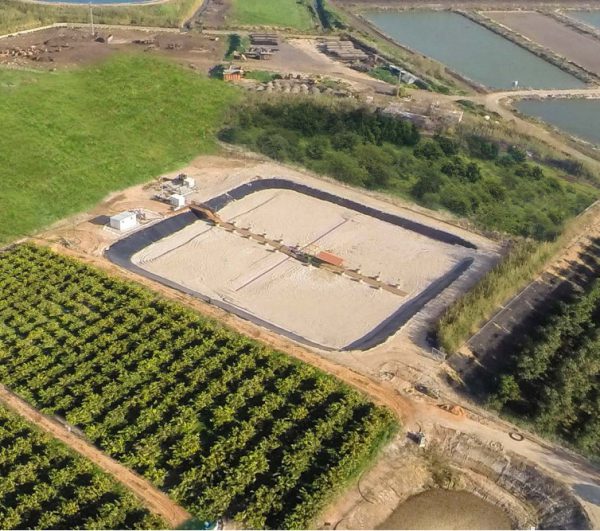
THE TAYA PROCESS
In the TAYA process (shown in Figure 1) a basin is divided into two parts, each filled with media. The two basins are connected via a pumping chamber and an array of collection and distribution piping on the floor of the basin which is underneath and sometimes also within the media bed. Water in one basin is drawn evenly through the piping by a pump and distributed evenly through the piping of the other basin, until the first basin is drained and the second is full. Then the flow is reversed using the same piping and a second pump.
The unique energy efficient feature in the TAYA process is that the pumping cycle is divided into two stages: in the first stage, water flows by gravity until the level of the two basins is similar; in the second stage, the pump turns on to provide the water head for full filling of one basin and draining of the other. Each time a basin is filled, influent ammonia and COD are supplied to the biofilm growing on the media. Once drained, the biofilm is exposed to atmospheric oxygen for the nitrification and COD removal. Nitrate removal occurs too, especially in the lower layer of the media, which is exposed to water for a longer time and to oxygen for a shorter time.
Figure 1: TAYA process schematic flow diagram
Processes like TAYA can easily achieve common secondary treatment compliance with respect to BOD and TSS (as shown in figure 2) for which the 95th percentile of effluent COD, TSS, and BOD over more than 1 year of operation are 52mg/l, 18 mg/l, and 15 mg/l respectively. In other cases, TAYA has demonstrated 90% removal of ammonia and total nitrogen to below 10 mg/l.

Figure 2: Process performance of a TAYA installation over the first year of operation
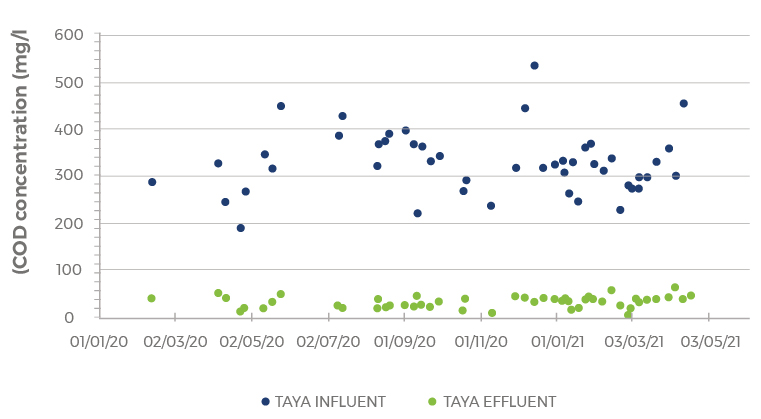
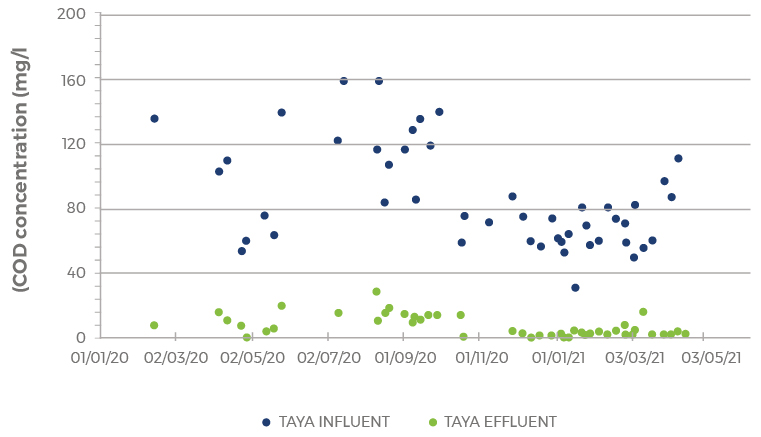
METHODOLOGY OF ENERGY CALCULATION
The most common way to express energy consumption in wastewater treatment is energy per unit volume or per unit mass of BOD removed, namely kWh/m3 or kWh/kg BOD, which do not account for or factor the removal of the entire load and might be somewhat misleading. These metrics are inconsistent, as they are sometimes reported for an entire treatment plant and other times for only part of the treatment plant. The recently published ISO 21939 standard [4] defines a scope and methodology to calculate, express, and report on the specific energy consumption of biological wastewater treatment plants, and overcomes the limitations of the older terms used for that purpose.
According to ISO 21939, energy consumption is normalized to net mass of oxygen consumption for all processes, defined there as NOR (net oxygen requirement). This includes BOD removal and nitrification; it accounts for denitrification and even dissolution of oxygen in the water. The calculation of NOR in terms of oxygen is based on a mass balance of the load removal for every constituent (LRi). Then, energy consumption of the scope of the process defined within the standard is divided by the NOR and expressed as NEC (net energy consumption, kWh/kg NOR). Due to its universal applicability in comparison between different cases, ISO 21939 was chosen as the primary metric for expression of the energy consumption in this work.
BASIS FOR SPECIFIC ENERGY CALCULATIONS
Design data

Wastewater and Effluent composition (mg/l)

RESULTS AND COMPARISON
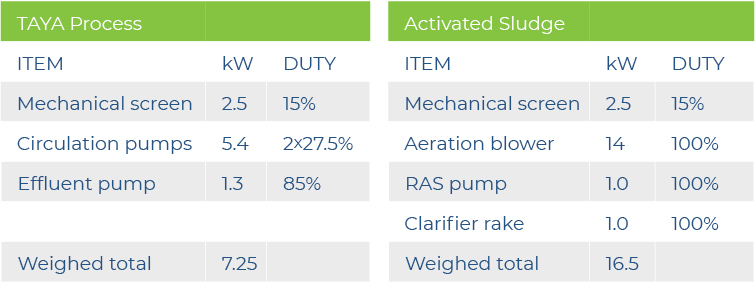
Note that the power of each component was multiplied by its duty (the part of the time it operates) in calculation of the weighed total.
The calculations shown below are based on terms and definitions in ISO 21939
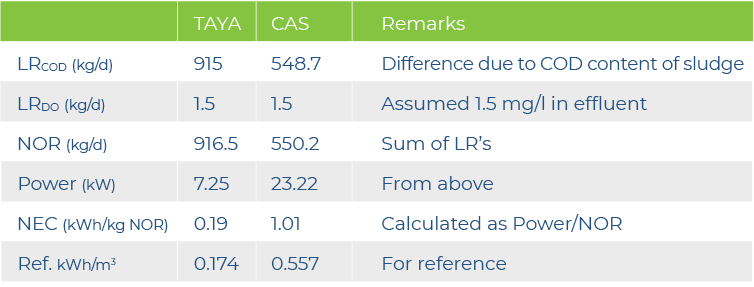
The specific energy consumption of the TAYA process is just 20% of the equivalent CAS design in terms of NEC according to ISO 21939. However, the actual TAYA power consumption in terms of kW, as well as the specific energy per unit volume treated, is about 30% of the CAS. The reason for this significant difference is sludge discharge from the CAS, which contains untreated COD values excluded from the treated load,
that differs from constructed wetlands which retains the sludge while degrading it over time as part of the process. This demonstrates that ISO 21939 also factors indirect metric values into the energy consumption that have real significance in comparison and decision between alternatives. It is noted that TAYA energy calculations are based on data from a full-scale installation over more than one year.
HOW TAYA RCW MEASURES UP TO CAS
This specific comparison of the energy consumption of a TAYA process to that of CAS shows that the TAYA process consumes only 20% of the energy of an equivalently performing activated sludge design, according to the new ISO 21939 standard, or in other words, saves 80% of the energy. In legacy terms, expressed per unit volume, the results show that TAYA consumes 30% of CAS (saves 70% of the energy). The different results arise because of the conventional expression of the specific energy consumption, which unlike the ISO standard, does not account for untreated COD and other values discharged as sludge, which would need to be treated downstream utilizing additional energy or incurring equivalent expense.
It may be concluded that reciprocating constructed wetlands, and TAYA specifically, cover an empty spot in the range of wastewater treatment solutions by providing an extensive and easy to operate process. This enables better control and smaller footprint than the conventional design, and still has a much lower energy consumption than activated sludge.
Authors: Amir Zalel, Dana Hubner, Keren Eisenberg, Ronen Shechter | WFI Group
REFERENCES
[1] Biological Wastewater Treatment Series, Volume Seven, Treatment Wetlands, Gabriela Dotro, Günter Langergraber, Pascal Molle, Jaime Nivala, Jaume Puigagut, Otto Stein, Marcos von Sperling, 2017 IWA publishing
[2] Activate Sludge – 100 years and counting, David Jenkins and Jiri Wanner (editors), IWA publishing, 2014
[3] Behrends L.L., Houke L., Bailey E., Jansen P., Brown D. (2001) Reciprocating constructed wetlands for treating industrial, municipal, and agricultural wastewater. Water Science and Technology 44(11-12):399-405
[4] ISO 21939



